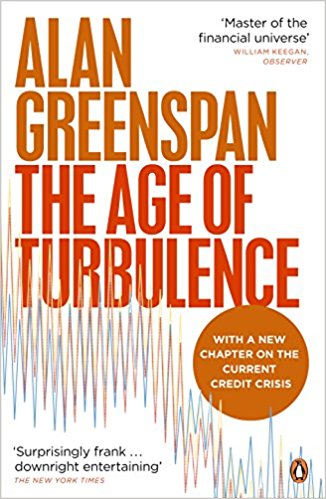Half of this book tells the story of the heady years between 1987 and 2006 when Alan Greenspan was the Chairman of America’s Federal Reserve Board, known to the whole world as simply the Fed. The other half consists of musings about the future and is actually quite disappointing. For almost 20 years, Alan Greenspan ran the world. The importance of the role the Fed plays is not known very widely. It controls, albeit indirectly, the money supply of the world and is in many ways the guardian of the world’s financial stability. Indeed, in that sense, he is almost as important as the American president (almost and not fully because the president controls the appointment of the Chairman). Greenspan’s long term also saw the world undergo one of the longest booms it has ever seen, which is now ending. Greenspan also oversaw a process that brought back monetary policy back to the centre-stage as the chief instrument of economic policy. The previous decades had belonged to fiscal policy and although Greenspan was not in charge when monetary policy began to reassert itself, he was the one who gave it full play.
The economic literature of the Greenspan era—and era is what it was—is different mainly in that it can never ignore the Fed and US monetary policy. Many would even argue that by the time he left in 2006, it had come to occupy centre-stage.
There was a reason for the resurgence of monetary policy, of course. By the time the 1980s ended, there were far too many dollars in existence to be ignored. Their presence had forced governments to liberalize the financial markets in the 1980s because with such liberalization, the dollars that belonged to the rich would not be able to earn high returns. By the time Greenspan took over, America’s financial sector, housed in New York’s Wall Street had begun to play the dominant role in America’s economy. It had also become wild and contained some real sharpsters who earned in hundreds of millions annually. In short, it had become the engine room of the American, and therefore the world, economy.
In that sense, even if Greenspan had wanted, he could neither have tamed it nor ignored it. He had only one option before him: to allow it even fuller latitude. The problem however was also of being able to control it fully. Greenspan knew that direct controls—you can do this but not that and only with our permission—had long become passe. He also knew that there was no instrument more powerful than price, the price of money included. The Fed had always controlled the price of money—it set the key interest rate in the US economy—but the trick was to ensure that the manner of setting it was effective. This was not an easy task at all but Greenspan figured out a way which made him different as well as truly great.
What set Greenspan apart was the fact that he understood not just how skittish financial markets could be but also the havoc they could cause. They needed to be handled with most extreme care and Greenspan made sure that they would be. Communication became the centerpiece of his strategy and the method Greenspan invented came to be known as Fedspeak. It comprised, essentially, of using ambiguous words to signal what was going to happen to the price of money. The trick was also never to use strong words to describe things. Mostly, instead of three words, 30 were used. Interpreting Fedspeak became an art and a profession in itself. At the centre of it all, sat Alan Greenspan, seldom seen or heard but when heard, taken with more seriousness the world over than even the American president.
If that was the method, what was the policy? It was, when one peels off the layers of deliberate obfuscation, quite simple really: use the supply of money and its price to fend off problems before they became too big and ensure that inflation is always under control. Indeed, Greenspan’s success in being able to expand output and keep inflation in check has earned the sobriquet of ‘The Great Moderation’. Never before in history had low inflation and high output growth gone on for so long. True, there was a two-year blip when the dotcom bubble burst in 2000. But thanks to Greenspan’s deft handling, things came back on even keel sooner than expected. The world economy resumed its onward march, which many thought would never stop until the sub-prime crisis halted it last year. Now the US economy is in a recession—which it is yet to admit—the financial system is trembling and everyone is blaming Greenspan for it. They are accusing him of feeding the beast beyond what it could digest. History can be cruel judge, as Alan Greenspan is discovering.
T.C.A. Srinivasa Raghavan is with the Business Standard.

